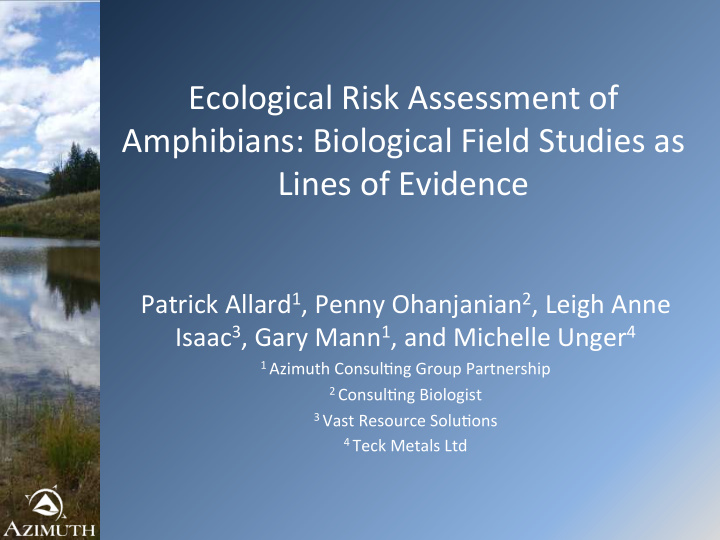



Ecological ¡Risk ¡Assessment ¡of ¡ Amphibians: ¡Biological ¡Field ¡Studies ¡as ¡ Lines ¡of ¡Evidence ¡ Patrick ¡Allard 1 , ¡Penny ¡Ohanjanian 2 , ¡Leigh ¡Anne ¡ Isaac 3 , ¡Gary ¡Mann 1 , ¡and ¡Michelle ¡Unger 4 ¡ 1 ¡ Azimuth ¡ConsulMng ¡Group ¡Partnership ¡ 2 ¡ ConsulMng ¡Biologist ¡ 3 ¡ Vast ¡Resource ¡SoluMons ¡ 4 ¡ Teck ¡Metals ¡Ltd ¡
PresentaMon ¡Overview ¡ • Background ¡ – Amphibians ¡in ¡ecological ¡risk ¡assessment ¡(ERA) ¡ – Technical ¡guidance ¡and ¡resources ¡ • Teck’s ¡former ¡Sullivan ¡Mine, ¡BriMsh ¡Columbia ¡(BC) ¡ • ERA ¡strategy ¡and ¡lines ¡of ¡evidence ¡(LOEs) ¡ – Methods ¡ – Key ¡findings ¡ • Lessons ¡learned ¡
Amphibians ¡in ¡ERA ¡ • Amphibians ¡are ¡found ¡at ¡many ¡contaminated ¡sites ¡ • Exposed ¡to ¡contaminants ¡in ¡mulMple ¡media: ¡ – Water, ¡sediment, ¡soil, ¡food ¡items ¡ • Permeable ¡skins ¡and ¡aquaMc/terrestrial ¡lifecycles ¡make ¡ them ¡vulnerable ¡to ¡contaminants ¡ ¡ ¡ ¡
Technical ¡Guidance ¡and ¡Resources ¡ • Federal ¡soil ¡and ¡water ¡quality ¡guidelines ¡are ¡not ¡always ¡ explicitly ¡protecMve ¡of ¡these ¡receptors ¡ • Very ¡limited ¡technical ¡guidance ¡and ¡tools ¡ – Limited ¡opportunity ¡for ¡food ¡chain ¡modeling ¡(lack ¡of ¡ toxicity ¡reference ¡values ¡for ¡most ¡contaminants) ¡ – Some ¡toxicity ¡tests ¡(frog ¡embryo ¡survival, ¡normal ¡ development, ¡and ¡growth ¡using ¡96-‑hr ¡FETAX ¡African ¡ clawed ¡frog ¡toxicity ¡test) ¡ • ERAs ¡either ¡ignore ¡these ¡receptors ¡or ¡tend ¡to ¡focus ¡on ¡ rare ¡and ¡endangered ¡species ¡
Technical ¡Guidance ¡and ¡Resources ¡ (Cont’d) ¡ • Recent ¡efforts: ¡ – Federal ¡Contaminated ¡Sites ¡AcMon ¡Plan ¡(FCSAP) ¡ERA ¡ Guidance ¡Module ¡7: ¡Amphibian ¡Risk ¡Assessment ¡ • RPIC ¡presentaMon ¡by ¡Ute ¡Po` ¡as ¡part ¡of ¡Stream ¡D3-‑ ¡ Guidance ¡ • ConcentraMon-‑response ¡relaMonships ¡(CRRs) ¡developed ¡ from ¡the ¡scienMfic ¡literature ¡(Cd, ¡Pb, ¡Zn) ¡ – Society ¡of ¡Environmental ¡Toxicology ¡and ¡Chemistry ¡ (SETAC) ¡-‑ ¡Ecotoxicology ¡of ¡Amphibians ¡and ¡RepMles ¡ Advisory ¡Group ¡
Secng ¡ • Former ¡Pb ¡& ¡Zn ¡ mine ¡with ¡90 ¡year ¡ history ¡ • ERA ¡for ¡post ¡ closure ¡(residual) ¡ metal ¡ contaminaMon ¡ • Wildland ¡with ¡ some ¡industrial ¡ use ¡(water ¡ collecMon ¡& ¡ treatment) ¡ • Many ¡natural ¡and ¡ man-‑made ¡ waterbodies ¡
ERA ¡Strategy ¡and ¡LOEs ¡ • ERA ¡studies ¡(including ¡Problem ¡FormulaMon) ¡ongoing ¡ since ¡2001 ¡ • Early ¡focus ¡on ¡rare ¡and ¡endangered ¡species; ¡expanded ¡ to ¡address ¡common ¡species ¡ • New ¡studies ¡in ¡2012-‑13: ¡ 1. IdenMfy ¡amphibians ¡species ¡and ¡their ¡habitats ¡ 2. Evaluate ¡links ¡between ¡measures ¡of ¡exposure ¡and ¡ effects ¡across ¡a ¡wide ¡gradient ¡of ¡metal ¡ concentraMons: ¡ • Soil ¡samples ¡at ¡912 ¡locaMons ¡ • Water ¡and ¡sediment ¡samples ¡in ¡19 ¡waterbodies, ¡plus ¡7 ¡ collecMon ¡systems ¡(high ¡exposure ¡= ¡posiMve ¡ref ¡toxicant) ¡
Study ¡Areas ¡and ¡Receptors ¡ Site ¡2 ¡ Site ¡1 ¡ Western ¡toad ¡ Pacific ¡chorus ¡frog ¡ Anaxyrus ¡boreas ¡(rare ¡ Pseudodacris ¡regilla ¡ & ¡endangered) ¡ Columbia ¡spo9ed ¡frog ¡ Long-‑toed ¡salamander ¡ Rana ¡luteiventris ¡ Ambystoma ¡macrodactylum ¡
ERA ¡Strategy ¡and ¡LOEs ¡(Cont’d) ¡ Three ¡main ¡LOEs: ¡ 1. Water ¡chemistry ¡vs. ¡CRR ¡informaMon ¡compiled ¡by ¡ Environment ¡Canada ¡for ¡cadmium, ¡lead ¡and ¡zinc ¡ ¡ 2. Field ¡biological ¡endpoints ¡vs. ¡exposure ¡gradient ¡ 3. Health ¡of ¡aquaMc ¡invertebrates ¡as ¡food ¡supply ¡ Endpoints: ¡ Total ¡of ¡113 ¡surveys: ¡ ¡ ¡ � PopulaIon ¡structure ¡ • Visual ¡encounter ¡surveys ¡ � ReproducIon ¡ • Nocturnal ¡road ¡surveys ¡ � Size ¡structure ¡ • ArIficial ¡cover ¡objects ¡ � Body ¡condiIon ¡ � Behaviour ¡ � Overall ¡distribuIon ¡
Water-‑based ¡CRRs ¡ • Literature-‑based ¡compilaMon ¡of ¡matching ¡concentraMon ¡vs. ¡ effect ¡size ¡for ¡a ¡variety ¡of ¡endpoints: ¡ – Mortality ¡and ¡malformaMons ¡at ¡different ¡life ¡stages ¡ – Different ¡test ¡duraMons ¡ – Many ¡different ¡species ¡ • Comparison ¡of ¡metal ¡concentraMons ¡over ¡Mme ¡(95 th ¡ percenMle) ¡across ¡Sites ¡1 ¡and ¡2 ¡waterbodies ¡(25 ¡water ¡ sampling ¡staMons) ¡ ¡
Example ¡for ¡Cadmium ¡ 23/25 ¡staIons ¡ Sullivan ¡Pond ¡ Woodstave ¡ Cr. ¡
Example ¡for ¡Lead ¡ 25/25 ¡staIons ¡
Example ¡for ¡Zinc ¡ 8/25 ¡staIons ¡ 15/25 ¡staIons, ¡incl. ¡ Sullivan ¡Pond ¡ references ¡and ¡Site ¡2 ¡ Woodstave ¡ Cr. ¡
Field ¡LOE ¡Methods ¡ Highlights: ¡ • All ¡animals ¡released ¡within ¡5 ¡min ¡of ¡capture ¡ • Nets ¡and ¡waders ¡bleached ¡and ¡nitrile ¡gloves/ziploc ¡ bags ¡used ¡to ¡prevent ¡spread ¡of ¡pathogens ¡ • Regional ¡datasets ¡available ¡for ¡western ¡toad ¡and ¡ spo`ed ¡frogs ¡to ¡provide ¡basis ¡for ¡off-‑site ¡comparison ¡
Key ¡Findings ¡of ¡Field ¡LOEs ¡ • Successful ¡reproducMon ¡and ¡ over-‑wintering ¡ ¡ • Broad ¡size ¡class ¡distribuMon ¡ and ¡all ¡developmental ¡ stages ¡(tadpole, ¡young-‑of-‑ year, ¡adults) ¡ • Healthy ¡appearance ¡and ¡ normal ¡behaviour ¡(righMng ¡ reflex) ¡ • Endpoints ¡comparable ¡to ¡ regional ¡datasets ¡ • UncertainMes: ¡ – Western ¡toad ¡distribuMon ¡
Key ¡Findings ¡of ¡Field ¡LOEs ¡(Cont’d) ¡
Context ¡for ¡InterpreMng ¡CRRs ¡ 8/27 ¡staIons ¡ 15/25 ¡staIons, ¡incl. ¡ Sullivan ¡Pond ¡ references ¡and ¡Site ¡2 ¡ ¡ Woodstave ¡ Cr. ¡ Western ¡toad ¡toxicity ¡data ¡
Context ¡for ¡InterpreMng ¡CRRs ¡(Cont’d) ¡ Sullivan ¡Pond ¡ Sullivan ¡Pond ¡ Woodstave ¡ -‑ Good ¡amphibian ¡ Cr. ¡ habitat ¡ -‑ Some ¡spo9ed ¡frogs ¡ and ¡abundant ¡chorus ¡ frogs ¡(tadpoles, ¡ metamorphs, ¡adults) ¡ Woodstave ¡Creek ¡ -‑ Poor ¡amphibian ¡habitat ¡ -‑ Small ¡ephemeral ¡creek ¡
Risk ¡Conclusions ¡ Amphibians ¡ ¡ (common ¡& ¡listed ) ¡
Lessons ¡Learned ¡ Field ¡biological ¡endpoints ¡integrate ¡ • exposure ¡and ¡effects ¡and ¡directly ¡ address ¡the ¡ERA’s ¡assessment ¡ endpoints: ¡ ¡ PopulaMons ¡of ¡common ¡species ¡ – Individual ¡organisms ¡of ¡rare ¡and ¡ – endangered ¡species ¡ Difficult ¡to ¡remove ¡influence ¡of ¡ • confounding ¡variables ¡(e.g., ¡habitat-‑ related ¡factors), ¡but ¡valuable ¡as ¡part ¡ of ¡weight-‑of-‑evidence ¡with ¡other ¡ LOEs: ¡ ¡ -‑ ¡ ¡ Literature-‑derived ¡CRRs ¡(Environment ¡Canada ¡FCSAP ¡guidance), ¡toxicity ¡ tesMng, ¡Mssue ¡chemistry ¡vs. ¡criMcal ¡body ¡burdens ¡ ¡
Thank ¡you! ¡
Recommend
More recommend